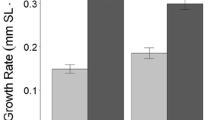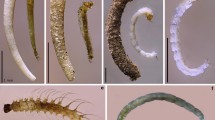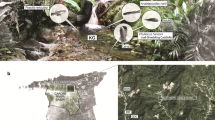Abstract
Theoretical efforts suggest that the relative sizes of predators and their prey can shape community dynamics, the structure of food webs, and the evolution of life histories. However, much of this work has assumed static predator and prey body sizes. The timing of recruitment and the growth patterns of both predator and prey have the potential to modify the strength of predator–prey interactions. In this study, I examined how predator size dynamics in 40 temporary ponds over a 3-year period affected the survival of spotted salamander (Ambystoma maculatum) larvae. Across communities, gape-limited predator richness, but not size, was correlated with habitat duration (pond permanence). Within communities, mean gape-limited predator size diminished as the growing season progressed. This size reduction occurred because prey individuals grew into a body size refuge and because the largest of the predators left ponds by mid-season. Elevated gape-limited predation risk across time and space was predicted by the occurrence of two large predatory salamanders: marbled salamander larvae (Ambystoma opacum) and red-spotted newt adults (Notophthalmus viridescens). The presence of the largest gape-limited predator, A. opacum, predicted A. maculatum larval survival in the field. The distribution of large predatory salamanders among ponds and across time is expected to lead to differing community dynamics and to generate divergent natural selection on early growth and body size in A. maculatum. In general, a dynamic perspective on predator size often will be necessary to understand the ecology and evolution of species interactions. This will be especially true in frequently disturbed or seasonal habitats where phenology and ontogeny interact to determine body size asymmetries.




Similar content being viewed by others
References
Abrams PA, Rowe L (1996) The effects of predation on the age and size of maturity of prey. Evolution 50:1052–1061
Abrams PA, Walters CJ (1996) Invulnerable prey and the paradox of enrichment. Ecology 77:1125–1133
Alford RA (1989) Variation in predator phenology affects predator performance and prey community composition. Ecology 70:206–219
Benard MF (2004) Predator-induced phenotypic plasticity in organisms with complex life histories. Annu Rev Ecol Syst 35:651–673
Brooks JL, Dodson SI (1965) Predation, body size, and composition of plankton. Science 150:28–35
Brunkhurst EP (2004) Predatory interactions between insects and spotted salamander larvae, Ambystoma maculatum, in vernal pools. University of Rhode Island, Kingston
Chase JM (1999) Food web effects of prey size refugia: variable interactions and alternative stable equilibria. Am Nat 154:559–570
Cohen JE, Jonsson T, Carpenter SR (2003) Ecological community description using the food web, species abundance, and body size. Proc Natl Acad Sci USA 100:1781–1786
Crawley MJ (2002) Statistical computing: an introduction to data analysis using S-Plus. Wiley, New York
Crowl TA, Covich AP (1990) Predator-induced life-history shifts in a freshwater snail. Science 247:949–951
Day T, Abrams PA, Chase JM (2002) The role of size-specific predation in the evolution and diversification of prey life histories. Evolution 56:877–887
de Roos AM, Persson L, McCauley E (2003a) The influence of size-dependent life-history traits on the structure and dynamics of populations and communities. Ecol Lett 6:473–487
de Roos AM, Persson L, Thieme HR (2003b) Emergent Allee effects in top predators feeding on structured prey populations. Proc R Soc Lond B 270:611–618
DeAngelis DL, Kitchell JA, Post WM (1985) The influence of Naticid predation on evolutionary strategies of bivalve prey: conclusions from a model. Am Nat 126:817–842
Durant JM et al (2005) Timing and abundance as key mechanisms affecting trophic interactions in variable environments. Ecol Lett 8:952–958
Fauth JE, Resetarits WJJ (1991) Interactions between the salamander Siren intermedia and the keystone predator Notophthalmus viridescens. Ecology 72:827–838
Formanowicz DR (1982) Foraging tactics of larvae of Dytiscus verticalis (Coleoptera: Dytiscidae): the assessment of prey density. J Anim Ecol 51:757–767
Gill DE (1978) The metapopulation ecology of the red-spotted newt, Notophthalmus viridescens (Rafinesque). Ecol Monogr 48:145–166
Gotceitas V, Colgan P (1989) Predator foraging success and habitat complexity: quantitative test of the threshold hypothesis. Oecologia 80:158–166
Hambright KD (1991) Experimental analysis of prey selection by largemouth bass: role of predator mouth width and prey body depth. Trans Am Fish Soc 120:500–508
Huey RB, Pianka ER (1981) Ecological consequences of foraging mode. Ecology 62:991–999
Juanes F, Conover DO (1995) Size-structured piscivory: advection and the linkage between predator and prey recruitment in young-of-the-year bluefish. Mar Ecol Prog Ser 128:287–304
Keast A (1985) The piscivore guild of fishes in small freshwater ecosystems. Environ Biol Fishes 12:119–129
Kurzava LM, Morin PJ (1994) Consequences and causes of geographic variation in the body size of a keystone predator, Notophthalmus viridescens. Oecologia 99:271–280
Lima SL (1998) Stress and decision making under the risk of predation: recent developments from behavioral, reproductive, and ecological perspectives. Adv Study Behav 27:215–290
Lima SL, Dill LM (1990) Behavioral decisions made under the risk of predation: a review and prospectus. Can J Zool 68:619–640
Loeuille N, Loreau M (2005) Evolutionary emergence of size-structured food webs. Proc Natl Acad Sci USA 102:5761–5766
McPeek MA (2004) The growth/predation risk trade-off: so what is the mechanism? Am Nat 163:88–111
McPeek MA, Brown JM (2000) Building a regional species pool: diversification of the Enalllagma damselflies in eastern North American waters. Ecology 81:904–920
Merritt RW, Cummins KW (1996) An introduction to the aquatic insects of North America, 3rd edn. Kendall/Hunt Publishing, Dubuque, Iowa
Paine RT (1976) Size-limited predation: an observational and experimental approach with the Mytilus-Pisaster interaction. Ecology 57:858–873
Paine RT (1980) Food webs: linkage, interaction strength and community infrastructure. J Anim Ecol 49:666–685
Paine RT, Trimble AC (2004) Abrupt community change on a rocky shore – biological mechanisms contributing to the potential formation of an alternative state. Ecol Lett 7:441–445
Persson L, Andersson J, Wahlstrom E, Eklov P (1996) Size-specific interactions in lake systems: predator gape limitation and prey growth rate and mortality. Ecology 77:900–911
Peters RH (1983) The ecological implications of body size. Cambridge University Press, Cambridge
Petranka JW (1998) Salamanders of the US and Canada. Smithsonian Institution, Washington D.C.
Pough FH, Andrews RM, Cadle JE, Crump ML, Savitzky AH, Wells KD (2001) Herpetology, 2nd edn. Prentice Hall, Upper Saddle River
Reznick D, Butler MJ, Rodd FH, Ross P (1996) Life history evolution in guppies (Poecilia reticulata) 6. Differential mortality as a mechanism for natural selection. Evolution 50:1651–1660
Scharf FS, Buckel JA, Rose KA, Juanes F, Cowan JJH (2006) Effects of variable prey and cohort dynamics on growth of young-of-the-year estuarine bluefish: evidence for interactions between spring- and summer-spawned cohorts. Trans Am Fish Soc 135:1266–1289
Scharf FS, Juanes F, Rountree RA (2000) Predator size–prey size relationships of marine fish predators: interspecific variation and effects of ontogeny and body size on trophic-niche breadth. Mar Ecol Prog Ser 208:229–248
Schmitz OJ (1998) Direct and indirect effects of predation and predation risk in old-field interaction webs. Am Nat 151:327–342
Schneider DW (1997) Predation and food web structure along a habitat duration gradient. Oecologia 110:567–575
Schneider DW, Frost TM (1996) Habitat duration and community structure in temporary ponds. J North Am Benthol Soc 15:64–86
Schoener TW (1971) Theory of feeding strategies. Annu Rev Ecol Syst 2:369–404
Skelly DK (2002) Experimental venue and estimation of interaction strength. Ecology 83:2097–2101
Skelly DK, Werner EE (1990) Behavioral and life-historical responses of larval American toads to an Odonate predator. Ecology 71:2313–2322
Sokal RR, Rohlf FJ (1995) Biometry: the principles and practice of statistics in biological research. W.H. Freeman and Co, New York
Stenhouse SL (1985) Interdemic variation in predation on salamander larvae. Ecology 66:1706–1717
Thygesen UH, Farnsworth KD, Andersen KH, Beyer JE (2005) How optimal life history changes with the community size-spectrum. Proc R Soc Lond B 272:1323–1331
Urban MC (2004) Disturbance heterogeneity determines freshwater metacommunity structure. Ecology 85:2971–2978
Urban MC (2006) Evolution and ecology of species interactions across multiple spatial scales. PhD thesis. Forestry and Environmental Studies, Yale University, New Haven
Urban MC (2007) The growth-predation risk tradeoff under a growing gape-limited predation threat. Ecology (in press)
Urban MC, Skelly DK (2006) Evolving metacommunities: Toward an evolutionary perspective on metacommunities. Ecology 87:1616–1626
van Wassenbergh S, Aerts P, Herrel A (2006) Scaling of suction feeding performance in the Catfish Clarias gariepinus. Physiol Biochem Zool 79:43–56
von Ende CN (2001) Repeated measures analysis: growth and other time-dependent measures. In: Scheiner SM, Gurevitch J (eds) Design and analysis of ecological experiments. Oxford UP, New York, pp 134–157
Walters CJ, Juanes F (1993) Recruitment limitation as a consequence of natural selection for use of restricted feeding habitats and predation risk taking by juvenile fishes. Can J Fish Aquat Sci 50:2058–2070
Wellborn GA, Skelly DK, Werner EE (1996) Mechanisms creating community structure across a freshwater habitat gradient. Annu Rev Ecol Syst 27:337–363
Werner EE, Gilliam JF (1984) The ontogenetic niche and species interactions in size-structured populations. Annu Rev Ecol Syst 15:393–425
Wilbur HM (1988) Interactions between growing predators and growing prey. In: Ebenman B, Persson L (eds) Size-structured populations. Springer, Berlin, pp 157–172
Wilbur HM (1997) Experimental ecology of food webs: complex systems in temporary ponds. Ecology 78:2279–2302
Wilbur HM, Fauth JE (1990) Experimental aquatic food webs: interactions between two predators and two prey. Am Nat 135:176–204
Williams RJ, Martinez ND (2000) Simple rules yield complex food webs. Nature 404:180–183
Wilson DS (1975) The adequacy of body size as a niche difference. Am Nat 109:769–784
Wissinger SA (1992) Niche overlap and the potential for competition and intraguild predation between size-structured populations. Ecology 73:1431–1444
Woodward G, Hildrew AG (2002) Body-size determinants of niche overlap and intraguild predation within a complex food web. J Anim Ecol 71:1063–1074
Acknowledgments
Comments by D. Skelly, M. McPeek, O. Schmitz, S. Stearns, F. Juanes, and J. Urban contributed to the development and communication of these ideas. Laboratory assistance was provided by S. Bolden, M. Holland, and E. Lee. Special thanks to V. Brady for measuring salamanders. This research was supported by grants from the Yale Institute for Biospheric Studies, Yale Center for Field Studies, Carpenter–Sperry–Mellon research fund, John F. Enders fund, and Perry Miller fund. The field collection methods used in my study comply with current state and US laws.
Author information
Authors and Affiliations
Corresponding author
Additional information
Communicated by Steven Kohler.
Electronic supplementary material
Below is the link to the electronic supplementary material.
Rights and permissions
About this article
Cite this article
Urban, M.C. Predator size and phenology shape prey survival in temporary ponds. Oecologia 154, 571–580 (2007). https://doi.org/10.1007/s00442-007-0856-2
Received:
Accepted:
Published:
Issue Date:
DOI: https://doi.org/10.1007/s00442-007-0856-2




